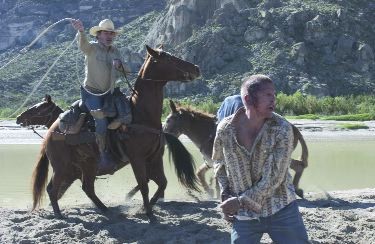The Three Burials of Melquiades Estrada

You might expect that a movie with the teasing title The Three Burials of Melquiades Estrada would deal with issues of redemption and resurrection. The film does brush up against themes of spiritual rebirth at times, but it is primarily concerned with friendship and the decision to honor the sanctity of friendship even after death.
Melquiades Estrada (Julio Cesar Cedillo) is a young Mexican vaquero who enters the U.S. illegally and finds work on a Texas ranch run by Pete Perkins (Tommy Lee Jones, who also directed the film). Pete doesn’t care about Melquiades’s status, but only that he is honest and hard-working. It doesn’t take long for the two men, who share a love of horses and the land, to become good friends.
A hotheaded border patrolman named Mike Norton (Barry Pepper of Saving Private Ryan) has just moved to the area. Mike is a bully and a racist, and one day, while out on patrol, he hears shots and returns fire, accidentally killing Melquiades, who was only trying to shoot a coyote who was threatening his goats.
At first, no one knows who killed Melquiades (Mike is too much of a coward to own up to his mistake), and no one in the lazy town much cares. Adopting the “just another dead wetback” posture on display throughout the film, the authorities bury Melquiades in a shallow grave and move on.
Except that Pete won’t let it go at that. He wants to know who killed his friend. When he finds out, he wants justice. When none is forthcoming, he decides to take the law into his own hands, meting out a “punishment” that fits the crime, at least in his mind.
The film’s structure and much of its tone is dictated by the script, written by Mexican novelist-screenwriter Guillermo Arriaga, who is best known in the U.S. for his time-shifting scripts for Amores Perros and 21 Grams. The first half of the film, in which we meet the principal characters, is told in Arriaga’s signature style—flashing back and manipulating time to dole out the exposition in small pieces. But once Pete makes up his mind to kidnap Mike, put him in Melquiades’s work clothes and force him to go to Mexico to bury Melquiades in his home village, the script becomes a far more traditional road movie with symbolic stops along the way.
Mike feels wronged, since Melquiades’s death was an accident. But he soon realizes—as do viewers—that this ride isn’t about Pete’s desire for revenge. In Pete’s calloused hands, Mike gets a lesson about the importance of one man’s life, no matter how insignificant it may seem to those around him.
Mike’s forced education is capsulized in a stark scene in which Pete takes Mike to Melquiades’s cabin before they hit the road. “Sit down at that table in that chair,” Pete tells him. “Melquiades lived here. That was his bed. That’s where he kept his clothes. He ate from that plate and that was his cup. Drink it. Drink from that cup.”
The variation in narrative styles has an effect on the supporting characters we meet. In town, we get to know the incompetent and sometimes impotent sheriff (Dwight Yoakam;) the tough-as-nails waitress who sleeps around (Melissa Leo); and Mike’s pretty but vapid wife (January Jones).
These stock figures are a contrast to the rich characters Pete and Mike meet on their journey, including a savvy trafficker in migrants with whom they negotiate to get information about the Rio Grande, a medicine-woman with a broken nose and a long memory, a group of cowboys watching soap operas in the back of a truck, and most memorable of all, a dying man (Levon Helm) who makes a simple request in exchange for a simple meal.
Though some critics have compared this film to Sam Peckinpah’s Bring Me the Head of Alfredo Garcia, a more apt comparison, especially in terms of tone, would be the earlier Peckinpah film Ride the High Country, about two aging cowboys—once good friends, now on opposite sides of the law—who must work through their past to accept their future. “I want to enter my house justified,” one of the old cowboys says—a line that could easily have found its way into The Three Burials of Melquiades Estrada.





